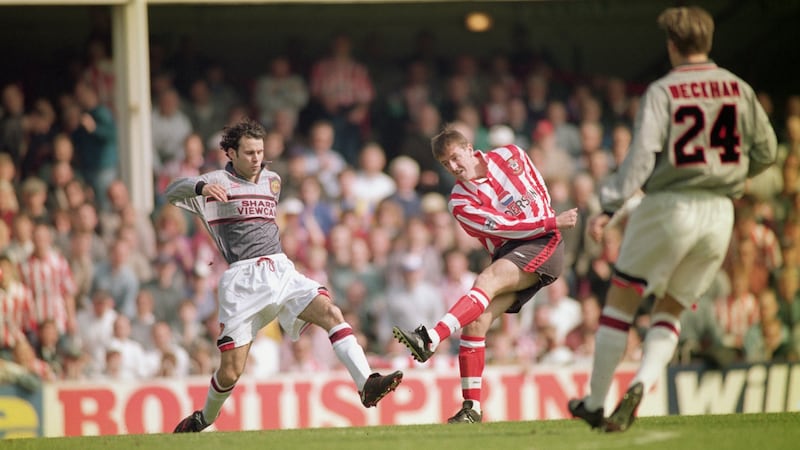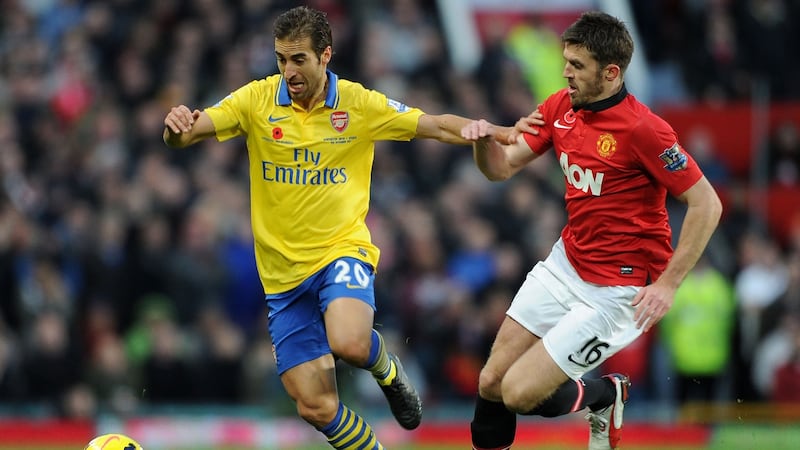Jersey sales.
It’s a term we hear a lot of when a club signs a new player – another revenue stream in the multi-billion euro juggernaut of professional football. Jerseys can give teams an edge in the technology that now goes into them, they act as billboards for major sponsorship deals and, years later, they provide physical pieces of memorabilia from the biggest moments in sport.
Some moments are remembered for jerseys alone such as the famous occasion in 1996 when Manchester United had to change their new grey kit at half-time because the players couldn’t distinguish each other from the crowd.
James McClean’s refusal to wear a poppy on his jersey becomes one of the biggest stories in English football every year around November time while the industry of retro football jerseys is booming.
All of this explains why these items kit are so important to teams. Indeed, back in 2014 Manchester United signed a 10-year kit deal with Adidas which is worth £750 million over that decade.
According to priceoffootball.com, Manchester City and Arsenal both make around £65 million per year on jerseys with Liverpool coming in around the £45 million mark but their deal is up for renewal at the end of the upcoming season and an increase would be expected thanks to their recent success with some reports suggesting that a new deal with Nike could eclipse even the numbers United are generating.

However, at the very top level those huge numbers can act as somewhat of a front. Jonathan Courtenay is the managing director of JACC Sports/Toplion, the Irish distributors of brands such as Umbro, New Balance and Under Armour. The company recently renewed its deal with the FAI to continue making all of the Irish gear until 2020 and Courtenay says that some of those very big deals can tend to be more of a marketing strategy.
“Realistically there are only two players who would influence jersey sales in any significant way and that’s [Lionel] Messi and [Cristian] Ronaldo,” he says.
“[David] Beckham used to sell shirts, not necessarily in England in any great numbers but certainly in the US and the Far East whereas Messi and Ronaldo are truly global. You’re as likely to see a kid in Beijing wearing a Ronaldo shirt as a kid in Ballyfermot.
“A lot of clubs see the likes of a Manchester United kit deal or a Real Madrid kit deal and they hear those kind of numbers that are announced around those deals but none of those deals make money. It’s literally a marketing spend, you can never make money back on that.
“What it does is it gives this unrealistic expectation so a lot of clubs who might not have the worldwide fanbase or the stadium capacity of the likes of those, they get this idea that there’s all these brands waiting to throw money at them which isn’t really the case. So that causes a bit of frustration in negotiations.”
Marketing spend
In many ways it’s a case of cutting out the middle man. Whereas traditionally customers would go to a shop and buy a jersey, brands are now looking to bypass the retailers and sell more of their products through their own channels.
Courtenay says that, by associating with worldwide clubs such as Manchester United or Real Madrid, those brands can build a loyalty in customers which will then enable them to sell other products that aren’t necessarily even linked to the club in question.
“Those big deals are marketing spend,” Courtenay says. “They wouldn’t stand on their own two feet and realistically they’re using it as a platform to sell other products that aren’t really related to the club and have it as a visibility thing so you’re promoting your own brand. The likes of New Balance, Adidas, Umbro will have those type of spends with certain clubs or federations but they’re never going to see returns in terms of shirt sales.
“Brands will overpay to get these deals because they won’t make money on shirt sales but what they’re trying to do is get that association with success and get that marketing credibility. But what they’re also trying to do is specifically promote their own brand.
“More and more brands are trying to sell products online through their own websites so ultimately they’re cutting out a lot of the retailers. So if a brand sells a shirt for, say, €75 and they sell it themselves, they make a bigger margin on it, whereas if they sell it through a retailer they’ll make around half that.
“So effectively for every shirt they sell themselves it’s like selling two to a retailer. They want to sell football boots, they want to sell trainers and other stuff which might not have the Man United brand on but people will associate the brand with that club.”
From 1980 to 1992 that brand for Manchester United was Adidas before a switch to Umbro for 10 years and then Nike from 2002 to 2015. However, since Adidas returned to making jerseys for the 20 times champions of England the deal has taken on a slightly different dynamic with re-released retro jerseys and tracksuits from the 1980s proving almost as popular as the new gear.
Courtenay says the jersey sales industry is “fairly stable” with spikes coming at times of success for clubs or countries but it’s the desire for nostalgia seen with Adidas and Manchester United that means the jersey memorabilia market is booming. Back in 2016, former Brazilian World Cup winner Pele decided to sell off much of his memorabilia in an auction that, in the end, collected $5 million in total.
Martin Nolan is the co-owner of Julien’s Auctions in the US, the company which handled the sale of Pele’s memorabilia. While buying a jersey of your favourite team allows you to show your support for them and to wear what the players on the pitch are currently wearing, he says that what sets a piece of memorabilia apart is that it gives the owner a tangible item from some of the greatest moments in sport.
Collectible market
“Sports is probably the biggest area of the collectible market, that’s where most of the money is,” Nolan says.
“We have a very good reputation and that’s very important when it comes to buyers looking for memorabilia so that they can ensure the origin of the item and know that it’s authentic. You’re talking great historic artefacts that are selling for several million dollars.
“During the negotiation process when we’re working with a seller they’ll have expectations in terms of price on various items. In any auction there might be 10 or so items that are very sentimental to them, very iconic and they’ll place a reserve on them which is the lowest prices they’ll sell it for and if they don’t get the reserve amount then it’s returned back to them.”
While items such as Pele’s are in a league of their own, it is some of the more unique jerseys in football that are remembered as much as the occasions on which they featured.
Back in 2013 Mathieu Flamini’s Arsenal jersey became a story in itself when he had to agree to stop cutting the sleeves off. The club has a strict tradition that dates back to the 1920s by which players must wear the same length sleeves as the captain who, in 2013, was the long sleeve-favouring Thomas Vermaelen.

However, Flamini preferred short sleeves and so took his scissors to his jersey before being reprimanded by the club a few days later. Interestingly, that jersey worn against Manchester United – which also featured a poppy and was therefore auctioned off for the Royal British Legion – attracted over £2,500.
It might seem that those jerseys which players pull on before a match and which fans wear when supporting their teams are just a piece of fabric but, in truth, there’s a whole lot more to them than that.
– This article is part of a series of consumer-based sports stories. If you have any queries, stories or issues regarding travel, tickets, sport on television or anything else you can email rcroke@irishtimes.com or via Twitter @Ruaidhri_Croke.












